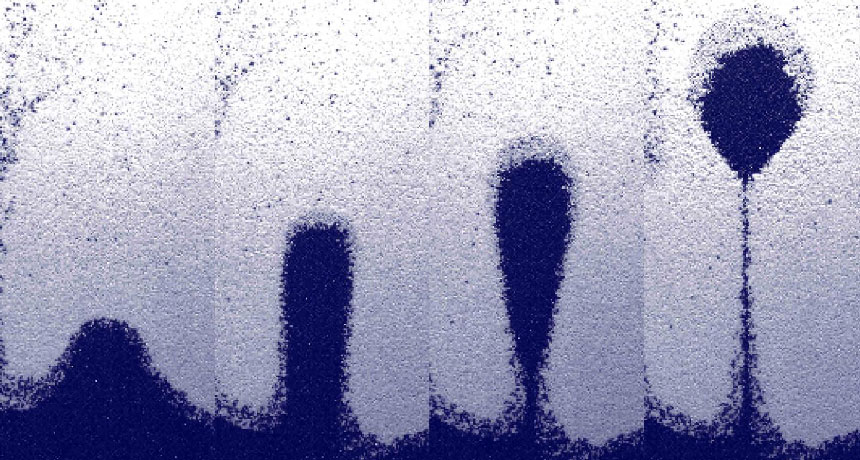
BUBBLING UP Gas flowing up through a gently vibrating glass chamber can cause solid grains to simulate a well-known fluid behavior. Here, bubbles of less dense sand (blue) rise through a layer of denser sand (white).
Alex Penn/ETH Zurich
- More than 2 years ago
Under the right conditions, sand can flow. When heavier grains are placed atop lighter grains in a container, the less dense grains can burble upward like the blobs of a lava lamp, a study finds.
The research is the first to show how the mixing of sand grains can mimic how fluids flow. But even when grainy particles, such as sand or mud, behave like fluids, the underlying forces that control how the grains move are different, researchers report online April 22 in the Proceedings of the National Academy of Sciences.
Understanding those forces could help scientists better explain the behavior of mudslides or of mixtures of hot gas and rock called pyroclastic flows from volcanoes. The research could also guide new technological designs for capturing carbon from the atmosphere or the production of pharmaceuticals.
Scientists had known that sand or other solid particles can behave like liquids under certain conditions. Strong earthquake vibrations, for example, can “liquefy” solid sand when it’s saturated with water. Less understood is how to mix grainy materials — from powders for pharmaceutical drugs to carbon dioxide-attracting beads — in the absence of water.
When dry, grainy particles of different sizes and densities move around one another, they tend to segregate themselves, or “demix,” says Richard Lueptow, a mechanical engineer at Northwestern University in Evanston, Ill., not involved in the new study. “This can create tremendous problems in creating uniform mixtures of particles in the pharmaceutical, chemical and food-processing industries.”
The research team, led by mechanical engineer Christopher McLaren of ETH Zurich, placed two types of round particles in a thin glass chamber: a layer of heavier particles sitting atop a layer of lighter particles. To get the grains moving, the team vibrated the chamber and sent gas upward through it. The particles “flowed” around one another like liquids of varying densities would, with bubbles or fingerlike streams of less-dense particles rising to the surface.
In fluid dynamics, the patterns formed as a lighter fluid pushes its way into a denser fluid are described by a phenomenon known as Rayleigh-Taylor instability, such as the burbles of hot wax rising in a lava lamp. The new research demonstrates for the first time that dry grains can simulate the instability.
That finding was surprising because this type of instability in fluids is related to the fact that the fluids can’t actually mix together. That’s not the case for solid grains, which are capable of completely mixing — and yet didn’t.
“We realized there was a completely different realm of physical mechanisms we’d have to get to the bottom of,” says study coauthor Christopher Boyce, a chemical engineer at Columbia University.
Computer simulations of the grains mixing revealed that the flow of gas as well as the vibrations controlled how the grains moved. When gas flowed through the chamber, it channeled differently between grains of different sizes and densities, creating an upward drag that helped to keep lighter particles clumped together. That prevented the particles from mixing, simulating how immiscible fluids, like oil and water, might behave. Altering the rate of gas flow, or the intensity of the vibration, produced different shapes, such as larger fingers of particles or bigger blobs rising through the chamber, the team found. Both gas and vibration were required for the grains to mimic patterns of fluid instability.
When the researchers placed a blob of heavy particles within a layer of lighter ones, a different pattern emerged. The grains behaved more like fluids that can mix — such as red dye in water. The heavy particles split into two blobs that fell through the lighter particle layer at an angle before splitting again, and again, in a branching pattern. That pattern also resulted from gas channeling up through the grains, the researchers found.
Previous studies using only vibration have observed that particles of different sizes move around each other in fluidlike ways, so that the largest particles end up on top, says Paul Umbanhowar, a mechanical engineer also at Northwestern University not involved in the new work.
That phenomenon is known as the “Brazil nut effect.” It’s thought to be the result of smaller particles slipping down between larger ones during shaking and leaving the bigger grains on top, like Brazil nuts in a can of mixed nuts (SN: 10/4/14, p. 4). But by incorporating gas flow, the study yields results that “are much more reminiscent of the behavior of normal fluids,” Umbanhowar says.






